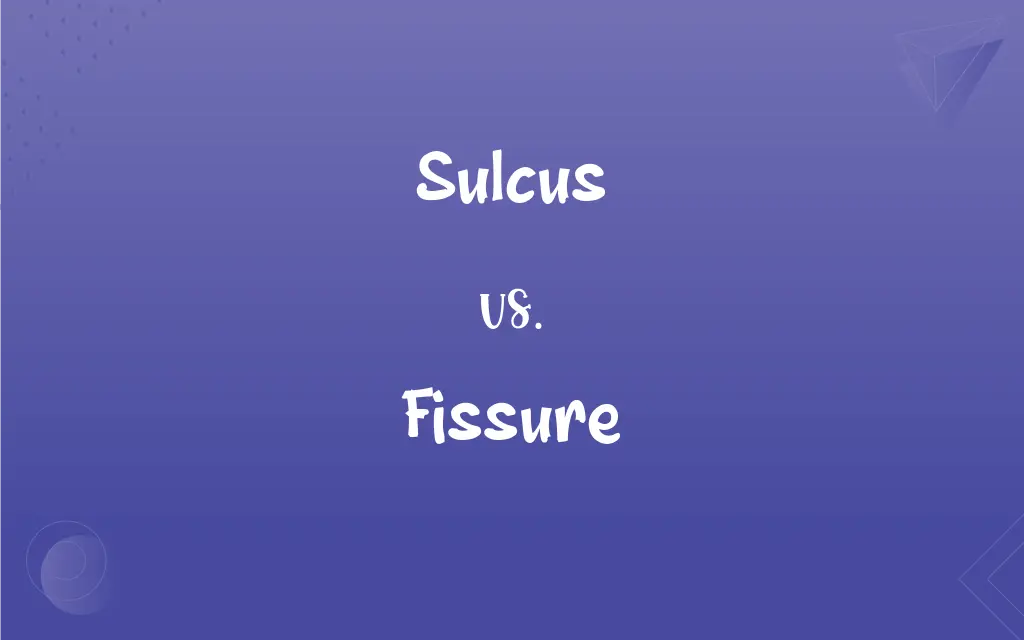Sulcus vs. Fissure: What's the Difference?
Edited by Janet White || By Harlon Moss || Updated on October 28, 2023
A sulcus is a shallow groove on the surface of an organ, while a fissure is a deeper groove or cleft that often separates distinct areas or lobes.

Key Differences
In the realm of anatomy, both sulcus and fissure are terms that refer to grooves or depressions found on the surfaces of organs. A sulcus typically describes a shallow groove, commonly seen on the brain's surface, distinguishing the folds of brain tissue called gyri. Conversely, a fissure is a deeper groove or cleft that can be found on various organs, but when referring to the brain, it often signifies a significant separation between lobes or major brain areas.
The human brain offers a clear distinction between a sulcus and a fissure. For instance, the central sulcus is a groove on the cerebral cortex, separating the frontal and parietal lobes. The lateral fissure, on the other hand, is a pronounced indentation separating the temporal lobe from the frontal and parietal lobes, indicating its deeper nature compared to a sulcus.
Apart from the brain, the terms sulcus and fissure can be applied to other anatomical contexts. For instance, in the eye, the sulcus is a groove between the iris and the ciliary body. Meanwhile, a fissure might refer to an opening or cleft in an organ, like the orbital fissure in the skull allowing nerves and vessels to pass through.
When examining the heart, the coronary sulcus is a groove that encircles the heart, separating the atria from the ventricles. In contrast, while the term fissure is less commonly associated with the heart, it can still represent a division or separation in other body parts, showcasing its broader anatomical relevance.
In summary, both sulcus and fissure play a vital role in describing anatomical features. While a sulcus denotes a more superficial indentation, a fissure indicates a deeper and often more significant division or cleft.
ADVERTISEMENT
Comparison Chart
Depth
Typically shallow groove.
Deeper groove or cleft.
Brain Association
Distinguishes folds (gyri) on the brain's surface.
Separates major brain areas or lobes.
Common Anatomical Sites
Brain, eye, heart.
Brain, eye, skull, lungs (fissures separate lung lobes).
Function
Often defines boundaries between smaller structures.
Often delineates significant separations or passageways for vessels and nerves.
General Description
Groove on the surface of an organ.
Deep groove or opening on an organ, sometimes allowing for the passage of structures like nerves.
ADVERTISEMENT
Sulcus and Fissure Definitions
Sulcus
The boundary delineating different sections of a surface.
The sulcus on the cerebral cortex helps differentiate the brain's gyri.
Fissure
A separation or division in an anatomical structure.
The orbital fissure allows the passage of certain nerves to the eye.
Sulcus
A minor trench or channel in anatomical parts.
The lens of the eye sits behind the ciliary sulcus.
Fissure
A pronounced indentation with more depth than a sulcus.
The brain's longitudinal fissure divides the organ into two hemispheres.
Sulcus
A groove marking the surface of an organ.
The coronary sulcus separates the atria from the ventricles in the heart.
Fissure
A deep groove or cleft in an organ or tissue.
The lateral fissure of the brain separates the frontal lobe from the temporal lobe.
Sulcus
A furrow or indentation in a structure.
The sulcus between the teeth and gums can collect bacteria if not cleaned properly.
Fissure
A split or opening in something, typically a body part.
An anal fissure can cause significant pain and discomfort.
Sulcus
A shallow anatomical groove or depression.
The central sulcus of the brain divides the frontal lobe from the parietal lobe.
Fissure
A natural division or groove in an organ.
The lungs have fissures that delineate their various lobes.
Sulcus
A deep, narrow furrow or groove, as in an organ or tissue.
Fissure
A long narrow opening; a crack or cleft.
FAQs
What is a sulcus?
A sulcus is a shallow anatomical groove or depression on the surface of an organ.
Can you name an example of a sulcus in the brain?
The central sulcus is a prominent example, separating the frontal and parietal lobes.
Does every sulcus have a corresponding fissure?
No, not every sulcus will have a corresponding fissure; they are independent features.
Are sulcus and fissure terminologies limited to human anatomy?
No, these terms are used in the anatomy of various animals as well.
How does a fissure differ from a sulcus?
A fissure is a deeper groove or cleft, often separating major areas or lobes in organs.
Is a fissure always deeper than a sulcus?
Generally, a fissure is considered deeper than a sulcus in anatomical contexts.
Are sulci and fissures unique to humans?
No, many animals have anatomical sulci and fissures, especially in their brains.
Can fissures be found in bones?
Yes, for instance, the orbital fissure is found in the skull.
Does the depth of a fissure have any significance?
The depth often signifies a more significant separation or division in the organ.
Do sulci and fissures change with age?
Yes, certain sulci and fissures, especially in the brain, can change or become more pronounced with age.
Can other organs have sulci and fissures?
Yes, many organs, like the heart and eyes, have both sulci and fissures.
Is the sulcus present in every organ?
No, not every organ will have a sulcus; its presence depends on the organ's structure and function.
Can fissures be artificially created?
In medical procedures, artificial fissures might be created for therapeutic reasons.
Why are these terms important in anatomy?
Sulcus and fissure help describe and differentiate specific structures and regions within organs.
Is the sulcus related to function or just structure?
While primarily structural, the presence of a sulcus can also relate to the organ's function.
What's the difference between the longitudinal fissure and the central sulcus?
The longitudinal fissure divides the brain into two hemispheres, while the central sulcus separates the frontal and parietal lobes.
Are there any diseases associated with sulci and fissures?
Some neurological conditions might affect the prominence or depth of sulci and fissures in the brain.
Is the number of sulci and fissures consistent among individuals?
Generally consistent, there can be variations in the number and depth of sulci and fissures among individuals.
Can injuries affect the sulcus or fissure?
Yes, injuries, like trauma or diseases, can alter or damage these structures.
Are sulci and fissures visible in medical imaging?
Yes, they are often visible in detailed imaging like MRI.
About Author
Written by
Harlon MossHarlon is a seasoned quality moderator and accomplished content writer for Difference Wiki. An alumnus of the prestigious University of California, he earned his degree in Computer Science. Leveraging his academic background, Harlon brings a meticulous and informed perspective to his work, ensuring content accuracy and excellence.
Edited by
Janet WhiteJanet White has been an esteemed writer and blogger for Difference Wiki. Holding a Master's degree in Science and Medical Journalism from the prestigious Boston University, she has consistently demonstrated her expertise and passion for her field. When she's not immersed in her work, Janet relishes her time exercising, delving into a good book, and cherishing moments with friends and family.































































